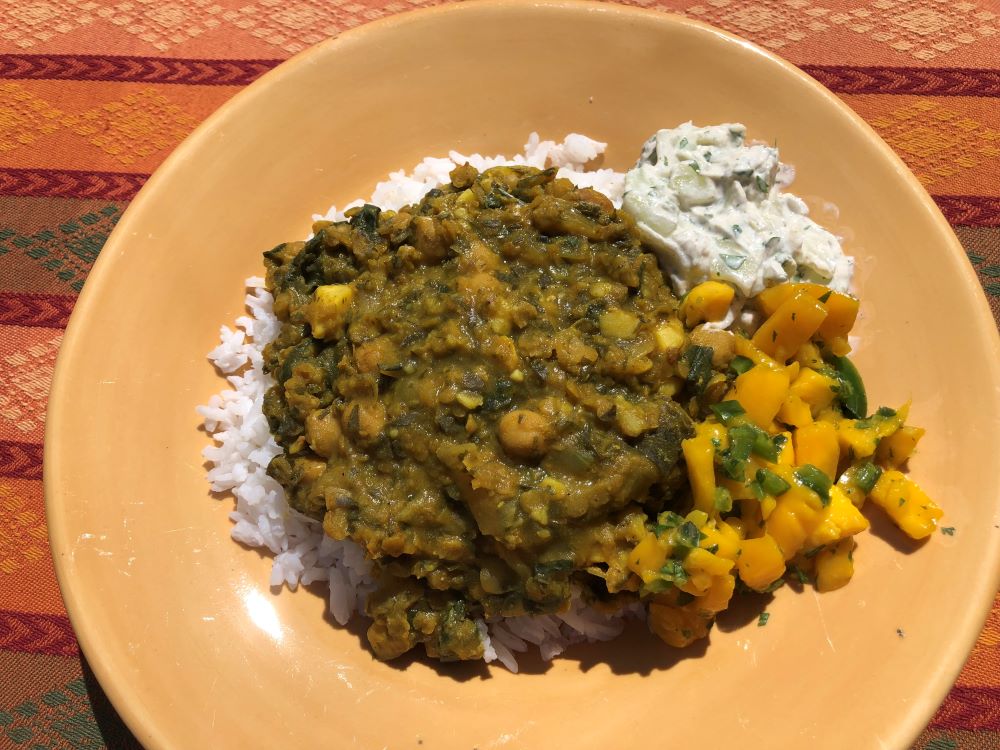Cook, for Goodness Sake!
This is so cool
By Linda Garrettson

It’s July, and it’s hot. The thermometer hit 90 degrees in the Icebox of Connecticut the day I wrote this article. What can we do but spend our days at Tobey Pond (my idea of heaven) or sit in an air-conditioned home?
In my world food solves many problems. So, what foods cool us? Cucumbers, for sure, and watermelon and raw salads. All the tropical fruits are cooling: pineapple, coconut, mango. Makes sense, right? But there’s another remedy for cooling down, unlikely as it may seem: curry. Hot, spicy, sweaty-upper-lip curry.
I discovered this phenomenon decades ago when I went to a dinner party on a tortuously hot night. When I heard that the hostess was serving curry, I was incredulous. Reluctantly, I dipped my fork in. Then I learned the cooling powers of curry. The rest of the evening went on in relative comfort, despite the thermometer readings.
Here are some curry basics:
Curries are dishes made with curry spices and other ingredients: tofu, meat, chickpeas, lentils and all kinds of vegetables.
Curry pastes are typically red, green or yellow. The color depends on the type of chilies used. Green is usually the mildest, red the hottest and yellow is somewhere in between.
Curry powder standards are turmeric, cumin, garlic and black pepper. They can also be made with coriander, cardamom, cayenne, fenugreek cloves, basil, nutmeg, ginger or black mustard seeds.
Curry makes you sweat, which cools you down in hot weather. Something called capsaicin in curry tricks your body into ramping up its cooling system. Turmeric lowers cholesterol and improves blood circulation. Cardamom and sweet basil lower blood pressure. Anyone for more curry?
Spicy foods are also good for the gut. I learned this on a trip to India when my GI system was in an uproar. A kind restaurant owner, seeing that I was green around the gills, encouraged me to eat some spice. Reluctantly, and thankfully, I did. My pallor changed rather quickly. I’ve since learned that spicy foods actually encourage good gut bacteria and cool that dragon.
So keep cool all you Norfolkers, and eat your curry.
Cooling Curried Chickpeas
Ingredients
½ onion, chopped
2 cloves garlic, minced
1 tsp sea salt
4 cups low sodium vegetable broth
Fresh turmeric, thumb size, peeled and grated
Fresh ginger, thumb size, peeled and grated
1 tsp cumin
1 tsp coriander
1 tbsp curry powder, your choice
1 14.5oz can chickpeas, rinsed and drained
½ cup dried red lentils, rinsed and drained
2 cups sweet potatoes, cubed (the purple-skinned Japanese variety are my favorites)
½ cup parsley, chopped
½ cup cilantro, chopped
1 1/2 cups fresh spinach, chopped
1 tsp apple cider vinegar
Method
• Sauté the onion, garlic and a few pinches of sea salt with ½ cup of vegetable broth in a large saucepan.
• Cook on medium heat until the vegetables sweat but do not brown.
• Add the turmeric, ginger, cumin, coriander and curry, stirring after each addition.
Try not to get intoxicated by the aroma.
• Add the remaining vegetable broth, chickpeas, potatoes and lentils.
• Bring to a boil, then reduce heat, cover and cook for 20-30 minutes, stirring occasionally.
• When the potatoes and lentils are soft, add the parsley, cilantro, and spinach.
• Continue cooking for five minutes until the greens are tender but still bright green.
• Finish with apple cider vinegar.
• Serve over white basmati rice with chutney and raita.
An easy-peasy recipe for riata is to peel and seed a cucumber, then slice it thinly. Add the cucumber to a zero fat yogurt with some chopped onions and cumin.
An equally easy chutney recipe is to peel a mango or two, and cut them into small cubes. Toss with finely chopped jalapeno pepper and some chopped cilantro.
